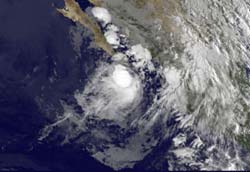GOES-11 catches quick birth of Tropical Storm Georgette already moving into Baja California

The GOES-11 satellite captured an infrared image of Tropical Storm Georgette\'s (left) clouds reaching into Baja California, Mexico at 13:15 UTC 9:15 a.m. EDT on Sept. 21.<br>Credit: NOAA/NASA GOES Project<br>
The Geostationary Operational Environmental Satellite or GOES-11 is stationary in its position in space, watching over the weather in the western U.S. GOES-11 captured an infrared image of Tropical Storm Georgette's rounded cloud cover stretching north into Baja California, Mexico at 13:15 UTC 9:15 a.m. EDT today, Sept. 21. GOES-11 imagery showed a smaller rounded area of clouds near Georgette's center, indicating higher clouds and stronger thunderstorms.
GOES-11 is operated by the National Oceanic and Atmospheric Administration, and images are created by NASA's GOES Project, located at NASA's Goddard Space Flight Center, Greenbelt, Md.
Because Georgette formed close to the coast there are already tropical storm warnings in effect for western Mexico. A tropical storm warning is in effect for the west coast of Baja California from Agua Blanca southward to Cabo San Lucas and the east coast of Baja California from Buenavista southward to Cabo San Lucas. A tropical storm warning means that tropical storm conditions are expected somewhere within the warning area – in this case within the next 12 to 24 hours.
Tropical Storm-force winds will move into Baja California and the warning area later today. Georgette is going to be a big rainmaker. Total rainfall amounts between 4 to 6 inches are expected with isolated amounts to 10 inches.
At 8 a.m. EDT (5 a.m. PDT/local time) Tropical Storm Georgette had maximum sustained winds near 40 mph and is expected to weaken once it gets over land in Baja California later today. Georgette is located about 60 miles south-southeast of Cabo San Lucas, Mexico near latitude 22.1 North and longitude 109.5 West latitude. Minimum central pressure is near 1001 millibars.
Georgette is moving north-northwest near 9 mph and is expected to move over the southern Baja later today. Then, Georgette is forecast to move into the Gulf of California tonight or Wednesday and become a remnant low pressure area, quickly dissipating over mainland Mexico.
Media Contact
More Information:
http://www.nasa.govAll latest news from the category: Earth Sciences
Earth Sciences (also referred to as Geosciences), which deals with basic issues surrounding our planet, plays a vital role in the area of energy and raw materials supply.
Earth Sciences comprises subjects such as geology, geography, geological informatics, paleontology, mineralogy, petrography, crystallography, geophysics, geodesy, glaciology, cartography, photogrammetry, meteorology and seismology, early-warning systems, earthquake research and polar research.
Newest articles

High-energy-density aqueous battery based on halogen multi-electron transfer
Traditional non-aqueous lithium-ion batteries have a high energy density, but their safety is compromised due to the flammable organic electrolytes they utilize. Aqueous batteries use water as the solvent for…

First-ever combined heart pump and pig kidney transplant
…gives new hope to patient with terminal illness. Surgeons at NYU Langone Health performed the first-ever combined mechanical heart pump and gene-edited pig kidney transplant surgery in a 54-year-old woman…

Biophysics: Testing how well biomarkers work
LMU researchers have developed a method to determine how reliably target proteins can be labeled using super-resolution fluorescence microscopy. Modern microscopy techniques make it possible to examine the inner workings…





















